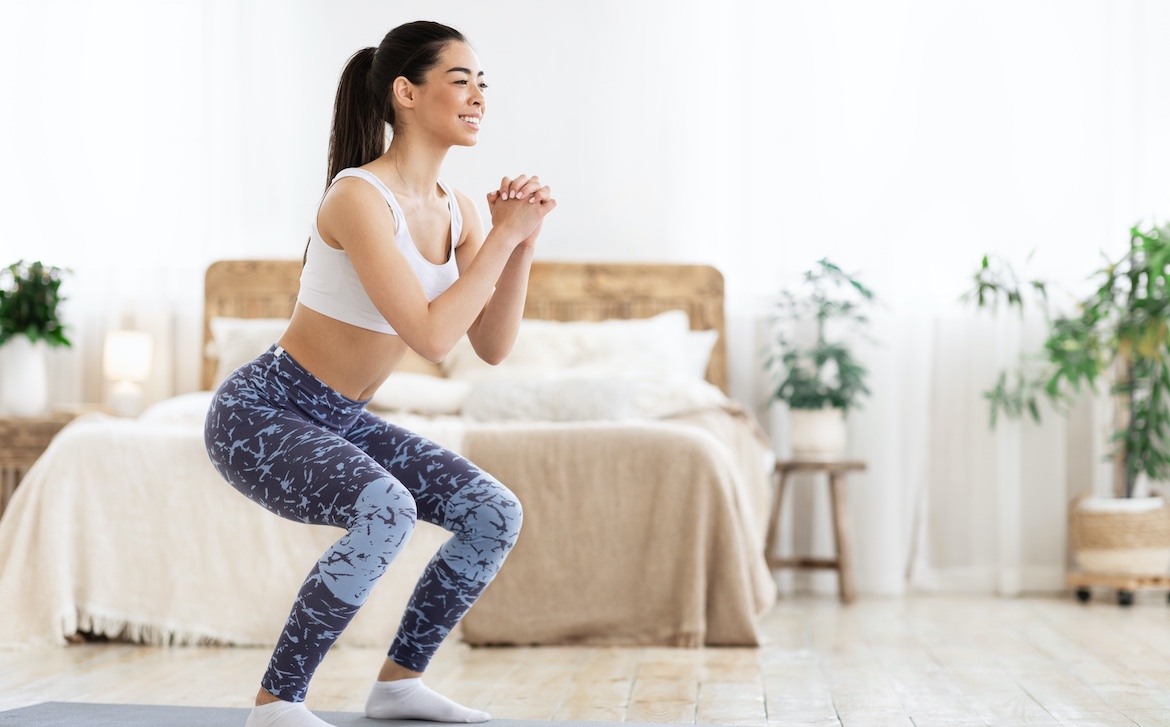But if you have heard of “dead butt syndrome,” then you know that the glutes can easily become weak and lazy if you don’t keep them active enough. That can lead to problems everywhere from the hips and back to the shoulders and neck as a result of poor spinal alignment, which increases your risk of injury and problems with balance.
And if you’re not getting dedicated glute workouts in, you’re likely not getting enough activation. “Because we sit at desk jobs, the glutes tend to be under-activated,” Scarfo says.
Working out your backside creates strong muscle tissue to best support your entire body. But not all glute exercises are created equal—some are simply ineffective, while others are too often performed with incorrect form. Scarfo suggests steering clear of these four options, and offers advice on what to do instead.
Quarter squats
It’s not uncommon to see people doing mini squats with exaggerated hip thrusts to try to build their glutes. “While doing shallow squats at high reps might seem helpful for growing the glute muscles, they’re not doing much,” Scarfo says. Instead, you need to get down and go deep to challenge the glutes.
“One way to do this is by using a kettlebell or dumbbell and performing a goblet squat,” he says. With the weight at your chest, hinge at the hips to sit back into a squat—and keep sinking until you’ve reached your full range and depth. “Using your hamstrings and glutes, push up from the squat and make sure your knees track outward,” he says. You can increase resistance with a heavier load as your glutes grow stronger.
Rushed glute bridges
“Now arguably, glute bridges aren’t bad, it’s just bad how most people do them,” Scarfo says. “If you’re doing glute bridges as fast as possible, you’re likely not getting the activation that you need to really build this muscle,” he explains. You want to move slowly and with control, giving your glute muscles a little squeeze when lifted, before sinking back to the floor.
To make it better, start by laying on your back with your heels near your butt and make sure your core is tight, so you’re really activating and exercising your abdominal and core muscles with this glute exercise, too. “These muscles will support your body during the glute bridge,” he says.
“Put force down through your heels and lift your butt off the ground, keeping your lower back supported and your core tight, then lift your hips as high as your range of motion will allow and squeeze at the top, where you can feel the activation through your glutes,” he says. Slowly lower your butt down to the ground before driving back up for another rep.
Glute kickbacks
One of the most common glute exercises at the gym and in exercise programs for targeting and strengthening the gluteal muscles, kickbacks require correct form to make the exercise effective and worthwhile.
“The big problem with kickbacks is that it’s often hard to properly load the glute muscle during the workout,” Scarfo says. “If you’re using a cable machine to add resistance to the movement, you’ll likely recruit your calf and hamstring to move your leg, and you’ll miss out on it giving you an optimal squeeze,” he explains.
Instead of kickbacks, do Romanian deadlifts. “This deadlift variation has limited injury risk, and allows you to really focus on loading the glutes, progressively raising your weights so that you can get the most benefit,” he says.
Start with lighter weights if you’re a beginner. “Holding light to moderate weights, with one in each hand, stabilize your back by retracting your shoulder blades and hinge at the hips to then slowly lower the weights down,” he says.
Keep them close to your body as you build tension in your glutes, and avoid allowing your back to roll. When you reach your complete range of motion, stop hinging at the hips and instead, using the tension in your glutes, slowly lift up, keeping shoulders tight and the back straight, for a full rep.
Fire hydrants
Similarly, abductor raises (aka fire hydrants) also present challenges with loading properly, and you may hinder your progress in developing and strengthening your glutes. “You also could introduce some imbalances as you compensate through the motion by lifting your knee,” Scarfo cautions.
Instead, do a curtsy lunge, which also introduces some core stability training and provides a more complex, full-body workout. Start by putting weight on your right leg, then move your left leg back and behind you, so that it’s crossing behind your body in a “curtsy” position. “To do the curtsy lunge, put the weight on the outside of your right foot and dip into the lunge, where—depending on your range of motion—it might not be a big movement, and might seem like a pulse,” he says.
Each pulse in the squat is one rep. Just make sure you keep your sides even and do the same number of reps on the other leg, too!

